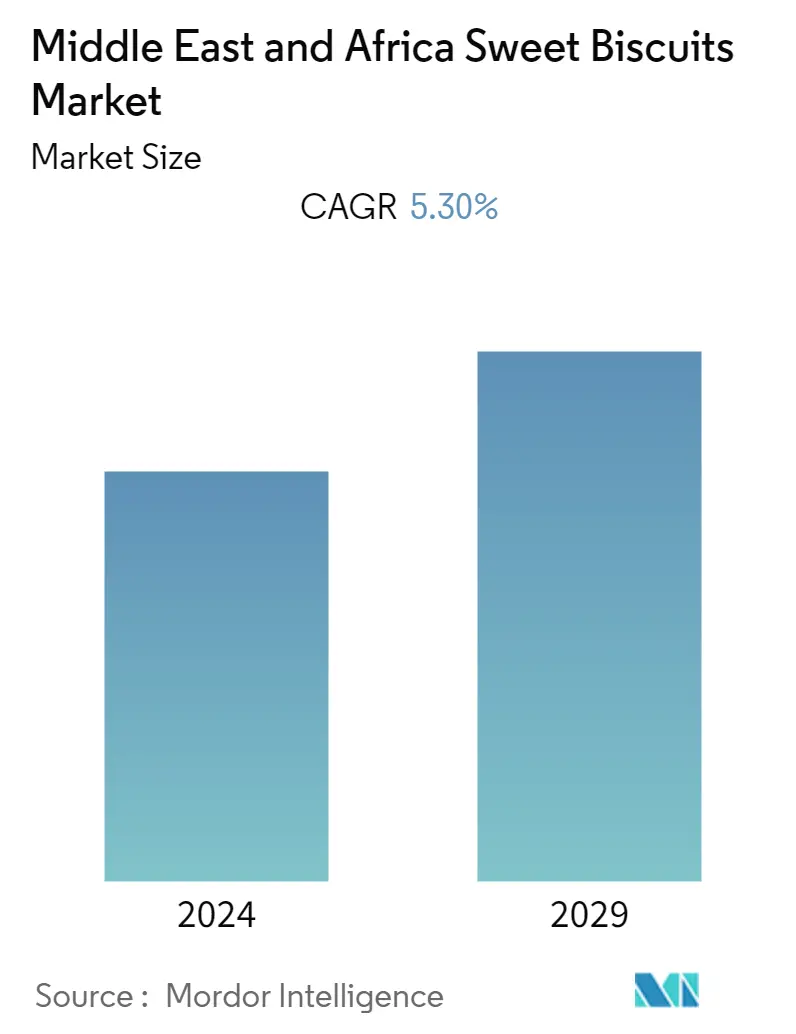Market Size of Middle East and Africa Sweet Biscuits Industry

| Study Period | 2019 - 2029 |
| Base Year For Estimation | 2023 |
| Forecast Data Period | 2024 - 2029 |
| Historical Data Period | 2019 - 2022 |
| CAGR | 5.30 % |
| Market Concentration | Low |
Major Players
*Disclaimer: Major Players sorted in no particular order |
MEA Sweet Biscuits Market Analysis
The Middle East and Africa Sweet Biscuits market is projected to register a CAGR of 5.3% during the forecast period, 2022-2027.
The market demand is driven by the demand for convenience and go-to snacks. Frequent product launches with new ingredients and tasty flavors to match the changing consumer preferences are enabling the sales of sweet biscuits in the Middle East and Africa. With a focus on new product development and marketing communications, the companies are also engaging in various in-store promotions. These in-store promotions are likely to center on money-off promotions, such as extra value packs or buy-one-get-one-free.
Moreover, the expanding popularity of clean-label snack food is promoting product innovation in the industry. Key brands are using plant-based ingredients in sweet biscuits and cookies to tap into a vegan consumer base. For instance, in January 2022, the United Arab Emirates vegan brand Kind Lyfe launched new Pecan Pie Cookie Dough Bites. The brand is known for its delicious and guilt-free vegan cookies. Further, the sweet biscuit varieties with labels such as gluten-free, preservative-free, and non-GMO are anticipated to gain significant demand during the forecast period.
MEA Sweet Biscuits Industry Segmentation
Sweet biscuits are flour-based baked products that are sweet in taste. The Middle East and Africa sweet biscuits market is segmented by type, distribution channel, and geography. By type, the market is segmented into plain biscuits, cookies, sandwich biscuits, filled biscuits, chocolate-coated biscuits, and other sweet biscuits. By distribution channel, the market is segmented into supermarkets/hypermarkets, convenience stores, online retail stores, and other distribution channels. It provides an analysis of emerging and established economies across the region, comprising Saudi Arabia, United Arab Emirates, South Africa, and the Rest of the Middle East and Africa.
| By Type | |
| Plain Biscuits | |
| Cookies | |
| Sandwich Biscuits | |
| Filled Biscuits | |
| Chocolate-coated Biscuits | |
| Other Sweet Biscuits |
| By Distribution Channel | |
| Supermarket/Hypermarket | |
| Convenience Stores | |
| Specialty Stores | |
| Online Retail Stores | |
| Other Distribution Channels |
| By Geography | |
| Saudi Arabia | |
| United Arab Emirates | |
| South Africa | |
| Rest of Middle-East and Africa |
Middle East and Africa Sweet Biscuits Market Size Summary
The Middle East and Africa Sweet Biscuits market is experiencing significant growth, driven by the increasing demand for convenient and on-the-go snacks. This demand is further fueled by frequent product launches that introduce new ingredients and flavors, catering to evolving consumer preferences. Companies are actively engaging in marketing strategies, including in-store promotions such as money-off deals, to boost sales. The trend towards clean-label snack foods is encouraging innovation, with brands incorporating plant-based ingredients to attract vegan consumers. The market is also seeing a rise in demand for sweet biscuits labeled as gluten-free, preservative-free, and non-GMO, appealing to health-conscious consumers. The younger demographic, along with kids and working-class individuals, are key consumers of these baked goods, contributing to the market's expansion.
The competitive landscape of the Middle East and Africa Sweet Biscuits market is marked by the presence of both regional and international players, such as Britannia Industries Limited, Gandour, and Yildiz Holding Inc. These companies are employing strategic initiatives like product launches, partnerships, and acquisitions to strengthen their market position. The market is characterized by a diverse range of biscuit varieties, including butter-based, chocolate, cream-filled, and artisanal cookies, which are popular across all age groups. Innovative marketing campaigns and the availability of healthy biscuit variants through online and offline channels are further propelling market growth. The market's potential is underscored by investments in production capacity and expansion efforts by key players, ensuring a robust and competitive industry landscape.
Middle East and Africa Sweet Biscuits Market Size - Table of Contents
-
1. MARKET DYNAMICS
-
1.1 Market Drivers
-
1.2 Market Restraints
-
1.3 Porter's Five Force Analysis
-
1.3.1 Threat of New Entrants
-
1.3.2 Bargaining Power of Buyers/Consumers
-
1.3.3 Bargaining Power of Suppliers
-
1.3.4 Threat of Substitute Products
-
1.3.5 Intensity of Competitive Rivalry
-
-
-
2. MARKET SEGMENTATION
-
2.1 By Type
-
2.1.1 Plain Biscuits
-
2.1.2 Cookies
-
2.1.3 Sandwich Biscuits
-
2.1.4 Filled Biscuits
-
2.1.5 Chocolate-coated Biscuits
-
2.1.6 Other Sweet Biscuits
-
-
2.2 By Distribution Channel
-
2.2.1 Supermarket/Hypermarket
-
2.2.2 Convenience Stores
-
2.2.3 Specialty Stores
-
2.2.4 Online Retail Stores
-
2.2.5 Other Distribution Channels
-
-
2.3 By Geography
-
2.3.1 Saudi Arabia
-
2.3.2 United Arab Emirates
-
2.3.3 South Africa
-
2.3.4 Rest of Middle-East and Africa
-
-
Middle East and Africa Sweet Biscuits Market Size FAQs
What is the current Middle East and Africa Sweet Biscuits Market size?
The Middle East and Africa Sweet Biscuits Market is projected to register a CAGR of 5.3% during the forecast period (2025-2030)
Who are the key players in Middle East and Africa Sweet Biscuits Market?
Britannia Industries Limited, Gandour, Deemah United Food Industries Corp Ltd, Tiffany Foods Ltd and Yildiz Holding Inc. are the major companies operating in the Middle East and Africa Sweet Biscuits Market.

